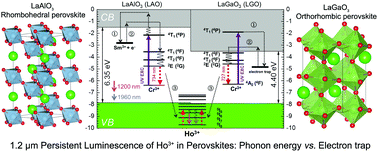当前位置:
X-MOL 学术
›
J. Mater. Chem. C
›
论文详情
Our official English website, www.x-mol.net, welcomes your
feedback! (Note: you will need to create a separate account there.)
1.2 μm persistent luminescence of Ho3+ in LaAlO3 and LaGaO3 perovskites†
Journal of Materials Chemistry C ( IF 5.7 ) Pub Date : 2018-10-01 00:00:00 , DOI: 10.1039/c8tc04393k Jian Xu 1, 2, 3, 4 , Daisuke Murata 1, 2, 3, 4 , Byoungjin So 5, 6, 7, 8 , Kazuki Asami 1, 2, 3, 4 , Jumpei Ueda 1, 2, 3, 4 , Jong Heo 5, 6, 7, 8 , Setsuhisa Tanabe 1, 2, 3, 4
Journal of Materials Chemistry C ( IF 5.7 ) Pub Date : 2018-10-01 00:00:00 , DOI: 10.1039/c8tc04393k Jian Xu 1, 2, 3, 4 , Daisuke Murata 1, 2, 3, 4 , Byoungjin So 5, 6, 7, 8 , Kazuki Asami 1, 2, 3, 4 , Jumpei Ueda 1, 2, 3, 4 , Jong Heo 5, 6, 7, 8 , Setsuhisa Tanabe 1, 2, 3, 4
Affiliation

|
Persistent luminescence (PersL) in the short-wave infrared (SWIR: ∼900–1700 nm) region has attracted much attention for potential biomedical imaging and night-vision surveillance applications. Although trivalent lanthanide (Ln3+) ions are considered to be one of the most promising luminescent centers working for this region, the lack of suitable persistent phosphor hosts is still the bottleneck of this field. Herein, by using the persistent energy transfer from Cr3+ to Ho3+, Ho3+ PersL at 1.2 μm has been realized in both Ho3+–Cr3+–Sm3+ tri-doped LaAlO3 (LAO:Ho–Cr–Sm) and Ho3+–Cr3+ co-doped LaGaO3 (LGO:Ho–Cr) perovskites. The Ho3+ photoluminescence (PL) intensity ratio between the 5I6 → 5I8 transition at ∼1.2 μm and the 5I7 → 5I8 transition at ∼2.0 μm in LAO is lower than that in LGO due to the higher phonon energy of the LAO host, resulting in its preferred population of the 5I7 excited level through multi-phonon relaxation (MPR) processes. However, the LAO:Ho–Cr–Sm phosphor still exhibits superior Cr3+/Ho3+ PersL intensity than that of LGO:Ho–Cr, and it is even comparable with that of the most widely used deep-red ZnGa2O4:Cr3+ persistent phosphor. This can be explained by the efficient electron traps of Sm3+ ions in LAO:Ho–Cr–Sm while this kind of sensitization by lanthanide ions seems not to work in LGO:Ho–Cr based on prediction from the vacuum referred binding energy (VRBE) diagram. These results demonstrated by the flexible ABX3 perovskites could give a vivid example to choose suitable material hosts, electron trapping centers and energy donor–acceptor combinations toward long PersL in the SWIR region.
中文翻译:

LaAlO 3和LaGaO 3钙钛矿 中Ho 3+的1.2μm持续发光†
短波红外(SWIR:〜900-1700 nm)区域中的持久发光(PersL)在潜在的生物医学成像和夜视监视应用中引起了极大的关注。尽管三价镧系(Ln 3+)离子被认为是该区域最有希望的发光中心之一,但缺乏合适的持久性磷主体仍然是该领域的瓶颈。在本文中,通过使用选自Cr持久能量转移3+何3+,何3+ PersL在1.2μm的已在两个何实现3+ -Cr 3+ -Sm 3+三掺杂的LaAlO 3 HO-:(LAO Cr–Sm)和Ho 3+ –Cr 3+共掺杂的LaGaO 3(LGO:Ho-Cr)钙钛矿。LAO中的5 I 6 → 5 I 8跃迁和〜2.0μm处的5 I 7 → 5 I 8跃迁之间的Ho 3+光致发光(PL)强度比在LAO中比在LGO中低,这是由于较高的Ho 3+光致发光强度比LAO主体的声子能量,通过多声子弛豫(MPR)过程导致其首选5 I 7激发能级。但是,LAO:Ho–Cr–Sm荧光粉仍显示出优异的Cr 3+ / Ho 3+PersL强度高于LGO:Ho-Cr,甚至可以与最广泛使用的深红色ZnGa 2 O 4:Cr 3+持久性荧光粉相媲美。这可以用LAO:Ho-Cr-Sm中Sm 3+离子的有效电子陷阱来解释,而基于镧系离子的这种敏化作用似乎是基于基于真空的结合能的预测而在LGO:Ho-Cr中不起作用的( VRBE)图。灵活的ABX 3钙钛矿证明了这些结果,可以为选择合适的材料主体,电子俘获中心和SWIR区域中长PersL的能量供体-受体组合提供一个生动的例子。
更新日期:2018-10-01
中文翻译:

LaAlO 3和LaGaO 3钙钛矿 中Ho 3+的1.2μm持续发光†
短波红外(SWIR:〜900-1700 nm)区域中的持久发光(PersL)在潜在的生物医学成像和夜视监视应用中引起了极大的关注。尽管三价镧系(Ln 3+)离子被认为是该区域最有希望的发光中心之一,但缺乏合适的持久性磷主体仍然是该领域的瓶颈。在本文中,通过使用选自Cr持久能量转移3+何3+,何3+ PersL在1.2μm的已在两个何实现3+ -Cr 3+ -Sm 3+三掺杂的LaAlO 3 HO-:(LAO Cr–Sm)和Ho 3+ –Cr 3+共掺杂的LaGaO 3(LGO:Ho-Cr)钙钛矿。LAO中的5 I 6 → 5 I 8跃迁和〜2.0μm处的5 I 7 → 5 I 8跃迁之间的Ho 3+光致发光(PL)强度比在LAO中比在LGO中低,这是由于较高的Ho 3+光致发光强度比LAO主体的声子能量,通过多声子弛豫(MPR)过程导致其首选5 I 7激发能级。但是,LAO:Ho–Cr–Sm荧光粉仍显示出优异的Cr 3+ / Ho 3+PersL强度高于LGO:Ho-Cr,甚至可以与最广泛使用的深红色ZnGa 2 O 4:Cr 3+持久性荧光粉相媲美。这可以用LAO:Ho-Cr-Sm中Sm 3+离子的有效电子陷阱来解释,而基于镧系离子的这种敏化作用似乎是基于基于真空的结合能的预测而在LGO:Ho-Cr中不起作用的( VRBE)图。灵活的ABX 3钙钛矿证明了这些结果,可以为选择合适的材料主体,电子俘获中心和SWIR区域中长PersL的能量供体-受体组合提供一个生动的例子。











































 京公网安备 11010802027423号
京公网安备 11010802027423号